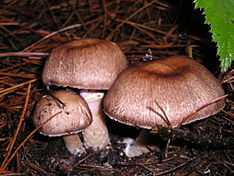Agaricus subrutilescens
| Agaricus subrutilescens | |
|---|---|
 | |
| Scientific classification | |
| Kingdom: | Fungi |
| Division: | Basidiomycota |
| Class: | Agaricomycetes |
| Order: | Agaricales |
| Family: | Agaricaceae |
| Genus: | Agaricus |
| Species: | A. subrutilescens |
| Binomial name | |
| Agaricus subrutilescens (Kauffman) Hotson & D.E.Stuntz (1938) | |
| Synonyms | |
|
Psalliota subrutilescens Kauffman (1925) | |
| Agaricus subrutilescens | |
|---|---|
|
| |
| gills on hymenium | |
| cap is convex | |
| hymenium is free | |
| stipe has a ring | |
| spore print is brown | |
| ecology is saprotrophic | |
| edibility: edible | |
Agaricus subrutilescens, also known as the wine-colored Agaricus, is a mushroom of the genus Agaricus. This mushroom is a good edible. It was first described scientifically in 1925 as Psalliota subrutilescens,[1] and later transferred to Agaricus in 1938.[2]
Description
Agaricus subrutilescens has a cap that is 5–13 cm (2.0–5.1 in) across, dry, and has many and wine to brown colored fibers, especially near the center. The gills are close and white at first, turning dark brown in age. The stalk has a skirt-like ring and is 4 to 20 cm (1.6 to 7.9 in) long, 1–3 cm (0.4–1.2 in) thick, long, white, and covered with soft woolly scales. The flesh is white and does not stain, and the odor and taste is pleasant.
The purplish fibrous cap and shaggy white stem differentiate this mushroom from others which resemble it.
Habitat and distribution
The mushroom fruits in undisturbed mixed woods in Western North America and Japan. It grows by itself or scattered in small clusters, often under redwood, pine, or alder.
See also
References
- ↑ Kauffman CH. (1925). "The fungus flora of Mt. Hood, with some new species". Papers of the Michigan Academy of Sciences 5: 115–48.
- ↑ Hotson JW, Stuntz DE. (1938). "The genus Agaricus in Western Washington". Mycologia 30 (2): 204–34. doi:10.2307/3754557.